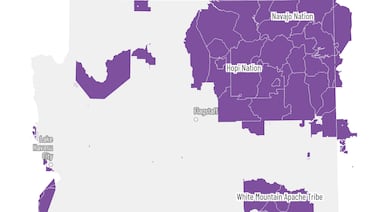Votebeat is a nonprofit news organization reporting on voting access and election administration across the U.S. Sign up for our free newsletters here.
As Sajda Blackwell approached the front of the room, she did a little dance of excitement — a shimmy as she pumped both fists in the air.
“All right, all right,” she said, as the woman standing in front of her shook a green leather bag filled with number tiles in preparation for Blackwell — a candidate for the 10th legislative district in west Philadelphia — to select one.
“Thirty-five, I feel alive,” she sang after pulling out her tile.
This wasn’t a game of chance at the local American Legion outpost. Instead, it was an official function of the Pennsylvania Department of State, held in Harrisburg last week. State House candidates had gathered to draw numbers establishing the order in which they would appear on the upcoming primary ballot.
A tile numbered between 31 and 40 is pulled from the bag, and the lower the number, the higher a given candidate appears on the ballot. The peculiar process, prescribed by the state’s Election Code, is how election officials ensure fairness in selecting who gets the coveted top ballot position.
States have a variety of ways of determining ballot order. Some go alphabetically. Some go by who filed their paperwork first. New Jersey separates candidates by whether they received their party endorsement, leading Andy Kim — a Democratic member of Congress who is running in that state’s U.S. Senate race — to file a lawsuit over the practice. He is running against Tammy Murphy, who as the governor’s wife would benefit from the influence of the top Democrat in the state.
Roughly two dozen state House candidates, some with their families, attended the drawing, which was held in the echoey atrium of the Keystone Building — an open-concept building across from the state Capitol building that sports a helicopter pad and often hosts large events. More than 300 candidates are running for the state House, but the room felt empty, and candidates chatted in groups of two or three as they waited.
Then, the process unfolded: Two state employees operated in tandem, one shaking a bag and the other recording the results after candidates, their proxies, or the department employee drew a two-inch-by-two-inch tile from the bag and held it up for all to see.Why 31-40? Over the years, the lower-numbered tiles had their corners bent, and much like a blackjack dealer at a casino, the department doesn’t want someone to figure out which tile is which before it is pulled.
“If you listed them alphabetically, that’s not fair. I would come at the end of the alphabet,” said William “Chris” Wyatt, a Republican candidate for State House in York, a south-central county. “By having the lottery, it balances things out.”
Being at the top of the ballot can be a boost for candidates with little name recognition. As an MIT Election Lab summary on the topic put it, “research into ballot-order effects has mostly confirmed common-sense beliefs on the subject: that appearing first increase[s] a candidate’s chances of performing well in an election.”
“You’re going to read through the names from top to bottom and being at the top is an advantage,” Brittany Crampsie, a Pennsylvania-based Democratic political consultant, said after the drawing. She added this is particularly true in low-information races with a large field of candidates.
Wyatt, a retired U.S. Army colonel, felt it was important to attend in person. Many did not, leaving the department employee to draw for them. In a green hoodie sporting a large white beard and cheerfully making conversation with other candidates, Wyatt stood out among the candidates who showed.
“That’s a high-speed, high-tech method,” he joked as he watched the department employee repeatedly shake the bag containing the tiles. “She’s going to have a sore arm by the end of this.” During municipal election years, counties also have to go through this selection process, and some add a little more flare.
Philadelphia uses a Horn & Hardart coffee can, which has its own parody account on X, the social media site formerly known as Twitter, and was dubbed the “can of destiny” by The Philadelphia Inquirer. York County uses an Utz potato chip can — the snack food company is headquartered there.
Pennsylvania’s selection process may seem odd, but is not completely without parallel.
Rhode Island used a ping-pong ball lottery machine like the ones you might find being used for the Powerball for their ballot position selection this year. Illinois has a similar process, as Cook County demonstrated last December when randomly drawing names from a plastic fishbowl.
Wyatt said he doesn’t believe in doing any ritual to increase his luck, though perhaps he could have used it. He strode confidently up to the podium as the department employee gave the bag several good shakes before motioning for him to reach in and grab his tile.
“Oof, that didn’t go well,” he said after drawing 38 from the bag.”Well, I’m not thrilled,” he told Votebeat and Spotlight PA after the draw.
Still, Wyatt shrugged off the bad tile, and didn’t seem particularly discouraged. There is still plenty of campaigning in front of him, and ballot position is only one factor.
“The key is to get in front of people,” he said. “Meet people.”
Carter Walker is a reporter for Votebeat in partnership with Spotlight PA. Contact Carter at cwalker@votebeat.org.





